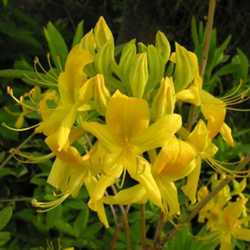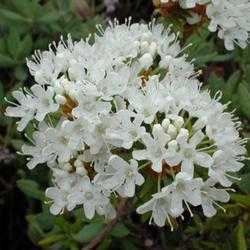(Editor's Note: This article was originally published on January 9, 2008.)
The genus Rhododendron is perhaps the most important genus of flowering shrub grown by gardeners in temperate regions of the world. Certainly, there are literally thousands of hybrids and more being developed every year! Of course, the problem with this genus is that most are not particularly hardy, especially the evergreen types. Deciduous azaleas are slightly hardier since they don’t have winter foliage. However, the standard azalea hybrids; the Exbury, Knap Hill and Ghents, are still only reliably hardy to USDA zone 5.
Recently, there has been significant breeding to develop hardier azaleas and rhododendrons. A whole series of super hardy evergreen rhododendrons are being developed in Finland, while closer to home, there is a series of very hardy deciduous azaleas called the 'Northern Lights' azaleas. These hybrids were developed at the University of Minnesota. Hybridizing started in 1957 but the first release was not until 1978. Breeding is still being carried out with two new releases in 2005. Most of the Northern Lights azaleas are hardy to -30 F or -34 C, allowing them to be successfully grown in USDA zone 4, with some even being successful in USDA zone 3. Many of these hybrids were the result of crossing the very hardy American species, R. prinophyllum and R. canadense to various Exbury-type Azaleas. While many of the resulting hybrids have smaller flowers than the standard azaleas, several do have reasonably large trusses. Many are fragrant and most have excellent red, orange and purplish fall colour. The following are the available hybrids (sorry I don't have pics of them all but my collection is still growing!):
‘Northern Lights’ - the hybrid that started it all. This one has pink flowers on a shrub to 8 feet tall, making it among the tallest of all the series. It was released in 1978.
'Pink Lights' - medium-pink flowers of medium size on a shrub reaching to 8 feet. This hybrid was developed in 1984. Unfortunately, it has proven difficult to propagate so is hard to find.
'Rosy Lights' - a deeper pink selection from the same cross that created 'Pink Lights'. It is very floriferous and more compact than ‘Pink Lights’, to 5 feet.

'Orchid Lights' - a compact hybrid using R. canadense as one of the parents. The flowers are the smallest of the Northern Lights but the plants are among the hardiest, known to survive to -40 F (-40 C). Plants form thick bushes to 3 feet. This hybrid was developed in 1986.
'Lemon Lights' - clear yellow flowers on a shrub that reaches to about 6 feet. Their flowers are reasonably large. It was released in 1996.

‘White Lights' - from pale pink buds open white flowers with the slighest hint of pink. Plants are sturdy and reach to 5 feet. It is the second hardiest in the group, next to 'Orchid Lights'. It was released in 1984.

'Mandarin Lights' - deep orange flowers, similar to those of the famous Exbury hybrid, 'Gibraltar'. The trusses are fairly large and plants reach 6-8 feet. It was released in 1996.

'Golden Lights' - orange-yellow flowers of a good size and substance. Plants reach to 4-6 feet. This hybrid has the best mildew resistance of any Northern Lights azalea. It was developed in 1994.
'Northern Hi-Lights' - a lovely two-toned flower; pale creamy-yellow to white with a prominant yellow blotch. The flowers are medium sized and plants reach to 4-6 feet. This hybrid arose from the same breeding stock as ‘Golden Lights’ and was also developed in 1994.

'Spicy Lights' - pink flowers with orange overtones make this hybrid one of the loveliest of the series. Plants reach 5-6 feet. It was released in 1987.

'Apricot Surprise' - unusual in the series, this hybrid was not named 'Lights' as were the rest. Plants are compact (3-4 feet) with small, often doubled flowers of a distinct apricot-peach tone. This hybrid also has a delightful scent. It was released in 1984.

'Tri-Lights' - a newer hybrid developed in 2003. The flowers are white with deep pink edges and a yellow blotch. It is not quite as hardy as the others in the series but has one of the strongest fragrances. Grows 4-6 feet.
'Western Lights' - a very recent introduction, this is a tetraploid version of 'Orchid Lights'. Plants look the same except the flowers are larger with more substance.
‘Lilac Lights’ - a new hybrid developed in 2005 from ‘Orchid Lights’. It has better mildew resistance than its predecessor.
‘Candy Lights’ - another new 2005 release, this one has flowers in a blend of white and light pink. Plants reach 3-5 feet.

















